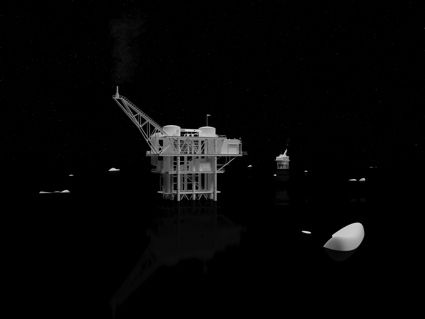
The project that Owen Wells developed and exhibited at the Design Interactions graduation show this year looks at the Arctic, a region that global changes has transformed into the new El Dorado.
It is feared that Arctic summer sea ice is melting at a rate faster than predicted, and could be ice free as early as 2015. The loss of sea ice and innovations in exploitation technologies are making the Arctic region more easily accessible. And more easily exploitable. The Arctic is indeed home to the world’s largest untapped gas reserves and an estimated 13% of the world’s remaining oil as well as vast mineral deposits are thought to lie beneath the ocean floor. The resources expose the Arctic to corporate greed and to potential geopolitical tension caused by unresolved sovereignty claims.
Well’s research project, Who Owns The Arctic, identifies the weakest territorial points and the legal loops in the status of the Arctic sea region to devise four subversive ways to overcome the legislation and shake the system that protects the Arctic.
Through an examination of the weaknesses of systems subversion can be seen as a form of critique – a deceitful narration of legitimate practices. With the help of several members of my own family who offered specific expertise, I have planned 4 subversive financial enterprises for the arctic. Each seeks to exploit the unique infrastructure, ecology, and legal ambiguity of the region to provide devious financial rewards. The project takes the form of scenes, maps and equipment. Through their planning, these schemes identify and expose the legitimate systems set to exploit the Arctic.
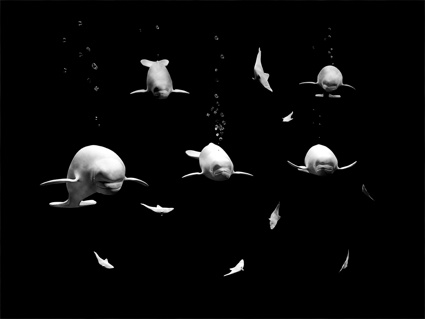
The first scheme is called The Mineral Rush. Under the guise of a normal fishing routine on the west coast of Svalbard, Russian men feed Beluga whales with by-catch stuffed with lithium. Whales soon start to show the early signs of lithium toxicity and after 5 days, suffer seizures, organ failure, and eventually die. When the mammals are washed onto the west coast of Svalbard, experts conclude that the metal in their bodies indicates the presence of vast deposits of lithium off the Svalbard coast. These rumors ultimately trickling through to the 39 signatory states of the Svalbard treaty, countries who retain the right to undertake commercial activities on the island without discrimination.
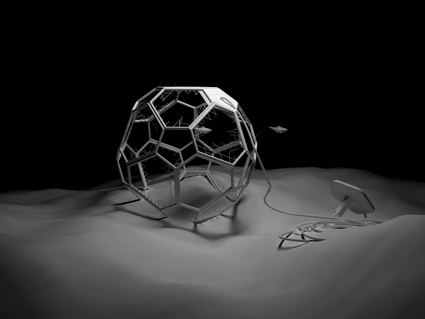 Crab pot
Crab pot
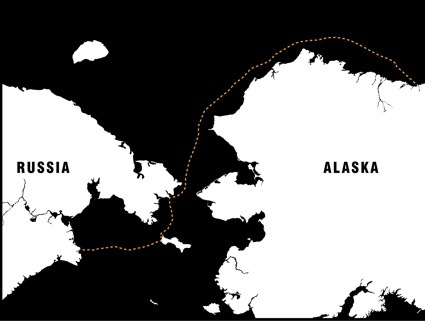 Fishing dispute route
Fishing dispute route
In the second scheme, The Fishing Dispute, Russian crab boats travel to the northern tip of the Bering sea. Once the ships have entered the Alaskan king crab fisheries, 20 icosahedron crab pots are deployed and the vessels return to waters within the Russian exclusive economic zone. 2 days later, they come back to tow the catch north, 1,600 km underwater. The pots are released in the Beaufort sea where fishing rights are still claimed by both America and Canada. After 5 days the cotton netting surrounding the pots dissolves, freeing the crabs. An anonymous press leak reporting catches of King crab far beyond their normal range is later sent to newspapers in both Barrow, Alaska, and Toktoyaktuk Harbor, Canada. The resulting scramble for the prized crab meat will greatly increase the opportunity for confrontation between Canadian and American fishermen, driven by confusion over fishing rights.
A third scheme involves an oil spill caused by devices placed on top of icebergs that travel from the northern tip of Greenland into to North Atlantic. On this journey they float past Hans Island and onto the oil fields of Baffin bay and the Labrador sea where, if spotted, they are usually towed a safe distance from the pipelines and oil rigs. But in this scenario the remotely activated devices would shake the iceberg apart. Still large enough to sink a ship or damage a rig, the smaller chunks of ice would not be detected by radar nor by the naked eye. The icebergs would thus float quietly onwards to the oil fields.
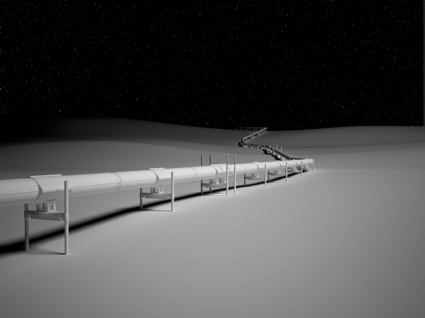
The last scenario involves a man working for the Keystone Pipeline, a pipeline system that transports oil sands bitumen from Canada and the northern United States “primarily to refineries in the Gulf Coast” of Texas. The man’s job is to operate a pig launching station. He makes extra money by smuggling goods across borders on board of a “pig“, a devices used to clean and survey the pipeline.
More details about each scheme can be found in this PDF.
Hi Owen! You asked members of your family to help you create 4 subversive financial enterprises for the Arctic. What are their areas of expertise? And why did you decide to work with members of your family? To show that anyone can do it?
Finding the true direction of the project was quite a painful process. After lots of research and deliberation looking for what I was interested in it dawned on me that specific friends and members of my immediate family had a really unique but highly specialised set of skills that I could hypothetically corrupt. I don’t want to give too much away about them because I respect their anonymity, but the main area of expertise I was able to draw upon centered around aspects of the shipping industry. It was through this advice that I was made aware of the Arctic as an environment where climate change is in the process of rendering the region potentially prone to corporate profiteering and political tension. In the latter stages of the project I also had advice on finance, and icebergs.
The dialogue around the amount of sensitive information readily available on the internet is pretty visible, particularly at the moment. While there is undoubtedly a huge amount of inspiration for potential deviants on the internet (The UN website offers information on how to set up shipping front companies if you’re willing to sit through some very dry videos) the opportunity to “physically” construct this kind of network, around the dinner table so to speak, was far too enticing. The implication that anyone can do it is defiantly a big part of the spirit of the project.
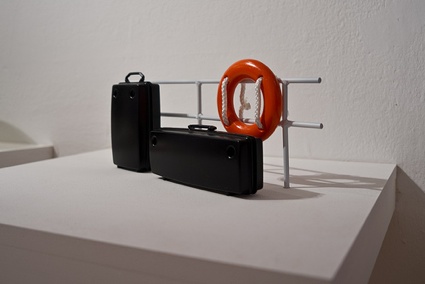 Owen Wells, Who Owns The Arctic. Installation at the RCA graduation show. Image d_&_r
Owen Wells, Who Owns The Arctic. Installation at the RCA graduation show. Image d_&_r
The texts describing the four enterprises in the show looked as if they were merely the start of a thriller. Why did you give just set the scene and didn’t go further in the description of the scenario?
I planned each of the four parts of the project pretty meticulously. I scouted locations, used google maps to plan how far and for long different actions would take. I produced inventories for different sections of the trips, found out how and where I get important pieces of equipment, and how many people were involved at any one time. Rather than display these as maps I decided to condense them into introductory texts. The scale of the schemes was far larger than anything I had dealt with before and so the texts gave me a way of contextualising them within the voice of individual characters. While specific locations might not be instantly recognisable I trust that the region is visible enough to begin to imagine what each of the schemes is suggesting.
In a way the schemes themselves serve as introductions – a way of describing the complexity of problems that climate change provokes beyond the environmental effects that everyone is aware of by now. There is room for them to be presented in more detail and I hope to develop the project beyond its current incarnation. Perhaps I might hold one of the arctic states to ransom in order to fund it.

 Ship Towing an Iceberg. Source: Randy Olson, National Geographic
Ship Towing an Iceberg. Source: Randy Olson, National Geographic
Several objects were exhibited in the show. Can you explain the one linked to the oil spill? How would it work exactly? Which technology does it use? And could you confirm how it would eventually trigger an oil spill? Would it be through an encounter similar to the one that sank the Titanic?
Of the four objects in the show that one is by far the most speculative in terms of how well it would work in the field. Icebergs are such an ominous symbols of danger that I had to include them, but they are notoriously difficult to destroy. The mechanisms through which they are created make them incredibly tough – there are reports of dropping bombs on them and only making a dent.
The device that I exhibited was an amalgamation of a helmholtz resonator and an autodialing device. The autodialing device would cycle through frequencies until it found the resonance frequency of the ice, similar to the way autodialling machines could theoretically crack a safe. The frequency would then resonate though the Helmhotlz resonator into fracture lines that are formed when icebergs calve from the face of a glacier and fall into the sea. The resonance effect would eventually cause the iceberg to break itself apart through vibration, forming smaller but potentially far more dangerous chunks of ice. In practice it is difficult to predict the effect this would have on an iceberg because it is dependent on structure not dampening the effects of resonance. I couldn’t confidently tell you if it would work in the field, but the object serves a narrative purpose so plausibility won out.
The weakness lies not in the icebergs themselves but in the system through which they are found and tracked. There are daily iceberg reports available through the International Ice Patrol (an entity whose existence was brought about by the sinking of the Titanic). Their main tool for finding Icebergs is Side looking Airborne Radar (SLAR), so if an object can evade radar (which smaller chunks of ice smoothed by the erosion of ocean are good at) then effectively it remains invisible to the system. Part of the current research on icebergs is about developing a way of towing them from collision courses with oil rigs. The actions of the individuals in the oil spill scenario are intended to make the icebergs invisible to radar by turning larger ones into fragments, flooding an oil rich area with ice that cannot be detected and hopefully (in this instance) won’t be spotted in time to be towed from a collision course.
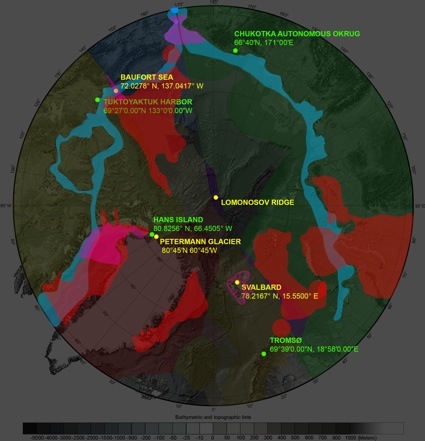 Potential weak points map
Potential weak points map
I’m afraid i didn’t understand very well the Mineral Rush scenario, the one with the Beluga whales poisoned by lithium. The start is crystal clear but it’s the consequences of the perceived presence of lithium off the Svalbard coast that isn’t so easy to understand. How are the 39 signatory states of the Svalbard treaty supposed to react to the lithium deposit?
The Archipelago officially became part of Norway under the terms of the Svalbard treaty. This treaty also states that the signatory countries (whose exact numbers fluctuate depending on what you’re reading) have equal rights to exploit mineral deposits in Svalbard. This scheme relies on the stock market to spread a rumor that there is a potentially valuable mineral wealth that has been made visible through its effects on the local food chain. Money could be made through buying land and the selling it once its value has risen due to the potential for prospecting. Alternatively the rumor could be used to engineer demand for legitimate infrastructure.
This one is by far the most complex of all the schemes and admittedly would benefit from a far more in depth demonstration of how it could function.
Finally, i was interested in knowing about antecedents for this exploitation of the weaknesses behind the laws and rules that protect the Arctic region. Did you come across similarly devious tricks from fishermen, speculators, businessmen or others?
Around Australia there are lots of reports of people smuggling operations exploiting a part of maritime law that states that you must always help a boat in distress. If the authorities intercept them on route then they will feign distress and by maritime law have to be towed to the nearest port rather than turned around. This only seems to delay the inevitable rather than allowing them to achieve their goal.
As I previously mentioned you can find out from the UN website a process that allows you to set up what amounts to a collection of front companies through a relatively cheap corporate web. This is a practice that is legitimate, pretty common in shipping, and is openly advertised. You have nominee directors and have physical shares that can be handed to people rather than existing digitally, so the real owner can remain anonymous. To see how this system worked at a very basic level, I got a quote to incorporate a company in the Marshall Islands on behalf of 5 Norwegian businessmen I pretended to represent; it was a very convenient service.
In the open ocean laws and rules become a little abstract because the high seas are still the high seas – Jurisdiction becomes incredibly complex and in some places redundant. There are international waters where ships come under the jurisdiction of the state under whose flag they sail, but if that state has no interest in bringing them to justice then law becomes unenforceable. Piracy proliferates in these areas. It’s completely anarchic in places, and forms a big part of international shipping discourse. Once the Arctic sea ice melts more thoroughly then ships will be able to pass through sea routes in the Arctic and avoid piracy areas, as well as save huge sums of money on fuel. This is why the Arctic is about to become so important to shipping.
If you want a good example of corruption at sea then have a look at the Salem case from 1980. It is too long to explain here but it involves government officials, a criminal sea captain and scuttling a supertanker during the South African oil embargo.
As for the Arctic I haven’t heard anything specifically about exploiting the law in the region. That doesn’t mean that there isn’t anything, but it still won’t be really accessible on a large scale for a number of years, so for now any underhand behavior is still hidden. At a governmental level the consensus appears to be to promote good relations between the Arctic states and protect the environment. This is fantastic, but the Arctic is a long way from prying eyes, so as a theatre of deviance (both “legitimate” and “illegitimate”) it will surely become a very attractive prospect, if not already.
If I may I would like to say thank you to Alexa Pollmann, Hyung-ok Park, Lana Z Porter, Mohammed Ali, Shing Tat Chung and the family and friends without whom this project would not have been possible.
Thanks Owen!
All images courtesy Owen Wells.
Also at the graduation show: Post Cyberwar Series and Circumventive hybrid organs.
